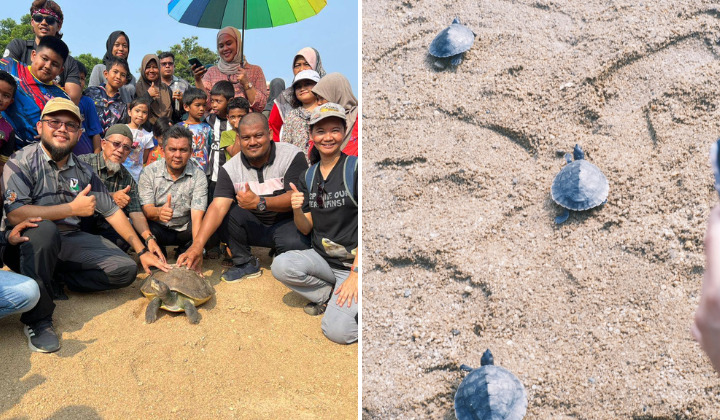Did You Know River Terrapins Are Called Tuntung Because Of The Sound The Females Make?
Get to know the critically endangered Southern River Terrapins and the woman pioneering their conservation efforts, Dr Chen Pelf Nyok.
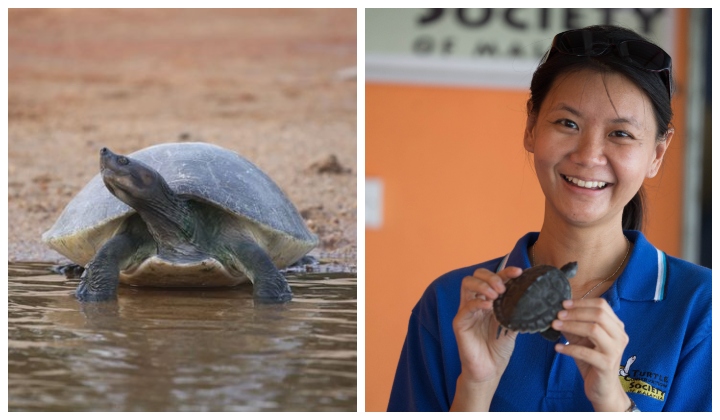
Subscribe to our Telegram channel for the latest stories and updates.
Before we get to that question, did you also know that tortoises are considered turtles? No, they’re not just the ones you think of, swimming in the sea.
A turtle is an umbrella term for all reptiles with a shell that develops from their ribs. They are mainly categorized into sea turtles, freshwater turtles and terrestrial turtles (tortoises).
Freshwater turtles are further categorized into two types, terrapins (hard-shelled) and soft-shelled turtles (labi-labi).
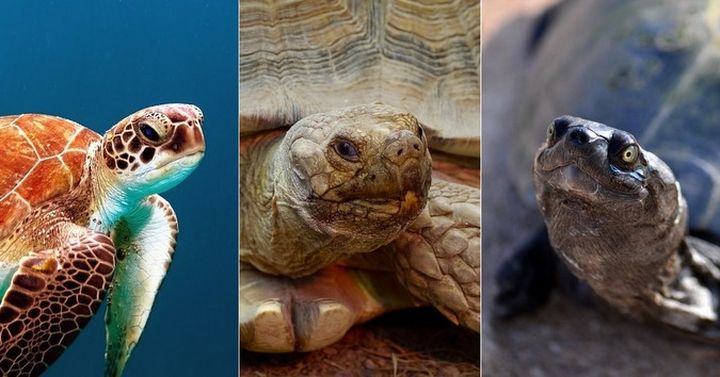
(Credit: Africa Geographic)
For your info, tortoises and terrapins can retract their heads inside their shells while sea turtles cannot.
Another tip to differentiate them is with their feet. Sea turtles have flippers, terrapins have webbed feet and tortoises have padded feet.
So, we’ve seen quite a lot of tortoises and we’ve definitely heard a lot more about sea turtles, but have you ever wondered about terrapins?
Thanks to our recent January trip to Club Med Cherating, we learned a lot about river terrapins from Marine Biologist, Dr Chen Pelf Nyok.
READ MORE: Should Club Med Cherating Be On Your Local Luxury Vacation Bucket List? [Review]
Dr Chen is a freshwater turtle researcher and conservationist, specializing in river terrapins, or what the locals call, Tuntung. She has been studying them for over 20 years and has even got a Commonwealth Point of Light award from Her Majesty Queen Elizabeth II for her turtle conservation efforts (only two people in Malaysia have received this award, including her, FYI). Even the locals in Terengganu call her Mek Tuntung.
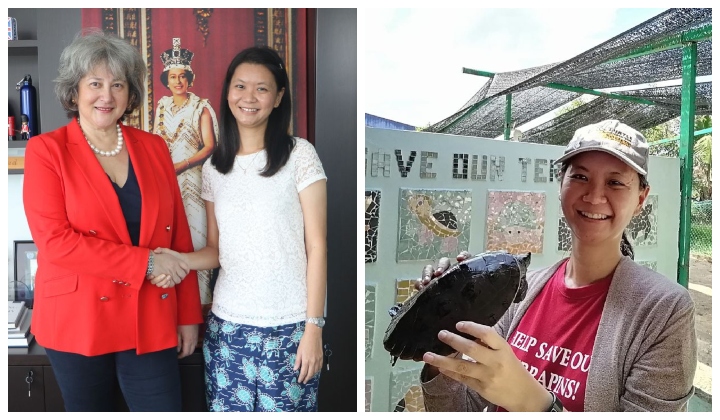
(Credit: Turtle Conservation Society)
In conjunction with World Wildlife Day (March 3) and International Womens Day (March 8), here’s our exclusive interview with Dr Chen on her life-long dedication to one of Malaysia’s less-spotlighted and critically endangered species, the Southern River Terrapins.
What are river terrapins?
There are a few types of River Terrapins. The Northern River Terrapins (Batagur Baska) are found in Bangladesh and India, the Southern River Terrapins (Batagur Affinis) are found in only Cambodia, Southern Thailand and Peninsular Malaysia while another one, called the Painted River Terrapins (Callagur borneoensis / Tuntung Laut in Malay) are found in Indonesia, Malaysia, Thailand, Sumatra, and Borneo.
All of them are classified as critically endangered by the IUCN Red List of Threatened Species. Not just endangered, but critically endangered, with the same urgency as our Malayan Tiger, Sunda Pangolin and the Bornean Orang Utan.
Now, let’s talk more about the Southern River Terrapins or what we call, Tuntung Sungai.
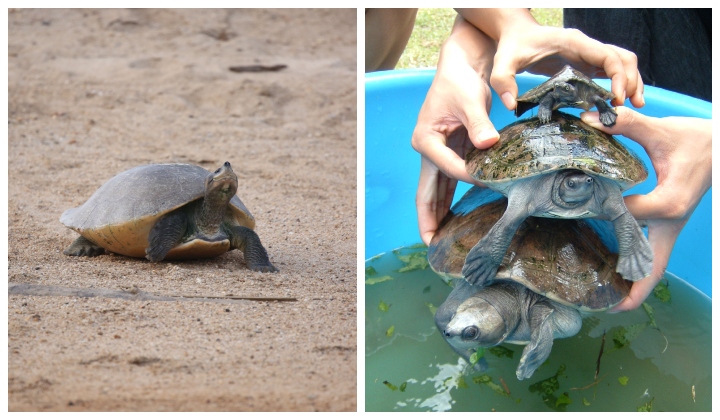
In Malaysia, the Southern River Terrapins are only found in the rivers of three states, which are Kedah, Perak & Terengganu. People can only see them up close when the females go up to the riverbed to lay their eggs at night, otherwise, you won’t find this little fella swimming up to you nonchalantly in the river.
A few years ago, I conducted a study to find if river terrapins are found in the rivers of Pahang since it’s near Terengganu but we couldn’t find any.
Dr Chen Pelf Nyok, Co-Founder of Turtle Conservation Society & Turtle Conservationist
We even talked to the local pakcik-pakcik along the major rivers of Pahang but many of them have never seen this river terrapins before.
Now back to the question of why they’re called Tuntung. River Terrapins are called that locally because of the sound the females make after laying their eggs.
After they have laid their eggs, female river terrapins will then raise their bodies and let go, producing a thumping sound on the ground.
Dr Chen Pelf Yok, Co-Founder of Turtle Conservation Society & Turtle Conservationist
This thumping sound, “tung, tung” is what the old local villagers have been describing these animals for all these years.
So whenever the locals heard this sound at night, they’ll automatically know that the terrapins are here!
Why do we need to protect them?
River Terrapins play an important ecological role in a river.
Tuntung helps keep the rivers clean by eating dead animal materials like dead snails and other carcasses in the river. They are also good at mangrove seed dispersal as they help plant mangrove seeds along the river when they defecate the product of the mangrove fruits they ate.
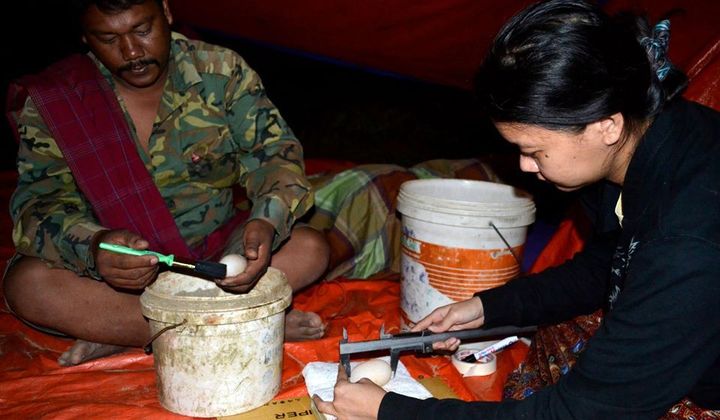
Furthermore, naturally, they provide a source of food and nutrients for other wildlife too like monitor lizards and wild boars who feed from their eggs. This happens naturally and is not the same with humans eating their eggs.
They perform all these good ecological roles but are highly threatened by human action.
Dr Chen Pelf Nyok, Co-Founder of Turtle Conservation Society & Turtle Conservationist
The human action that she’s talking about includes local villagers collecting their eggs to consume or to sell for profit. Currently, the TCS have been educating villagers and local people on the dangers of their customs and so far, most of the villagers agree and together they protect the river terrapins’ population.
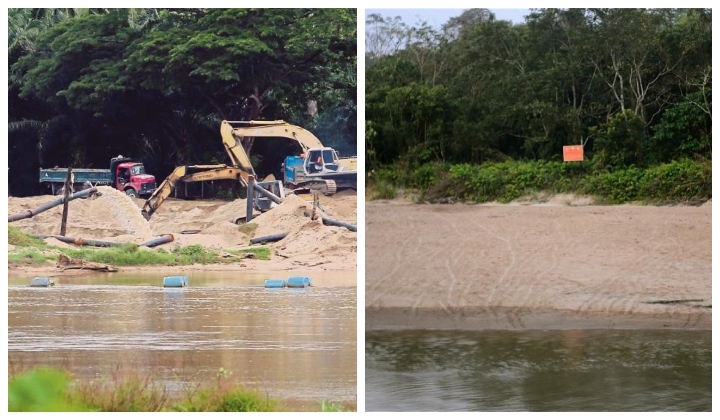
Other than that, mega construction projects that require sand mining activity from the riverbeds also threaten the survival of these terrapins. These projects destroy their nesting habitat, leaving no place for the terrapins to lay their eggs.
Besides that, terrapins can also be caught in fishing gear. Sometimes, they are caught in nets and also fishing rods as they may mistake the bait as food. Thankfully, now most of the locals who accidentally caught these terrapins in their gear have sent the animals to TCS for further action like removing the hook.
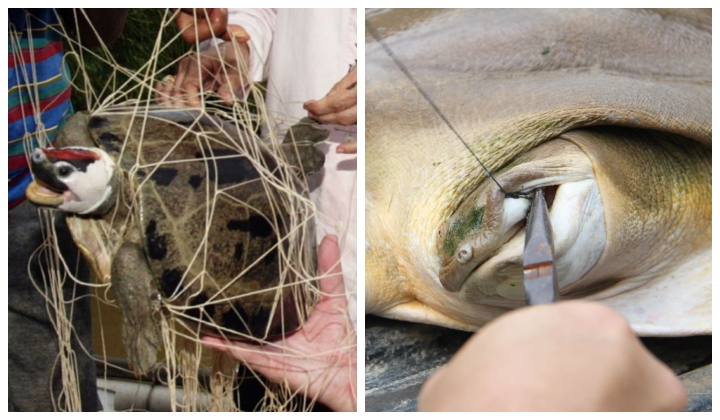
(Credit: Turtle Conservation Society)
Fun facts about southern river terrapins
Here are some fun facts regarding river terrapins.
- They are in the top 25 most critically endangered freshwater turtles in the world.
- Out of the 18 species of freshwater turtles and tortoises in Malaysia, river terrapins are given the ‘totally protected’ status in the Wildlife Conservation Act of 2010, compared to others who are just ‘protected’.
- They have an upturned snout so they can feed on mangrove leaves and fruits that fall into the river.
- Adults are herbivores and feed on mangrove apples, sedges, screw pines and water hyacinths.
- During mating season, the head of the males turns jet black and their irises turn yellow to attract the attention of females. Most freshwater species in the genus batagur change their head colour during mating season.
- They mate in the river during monsoon season.
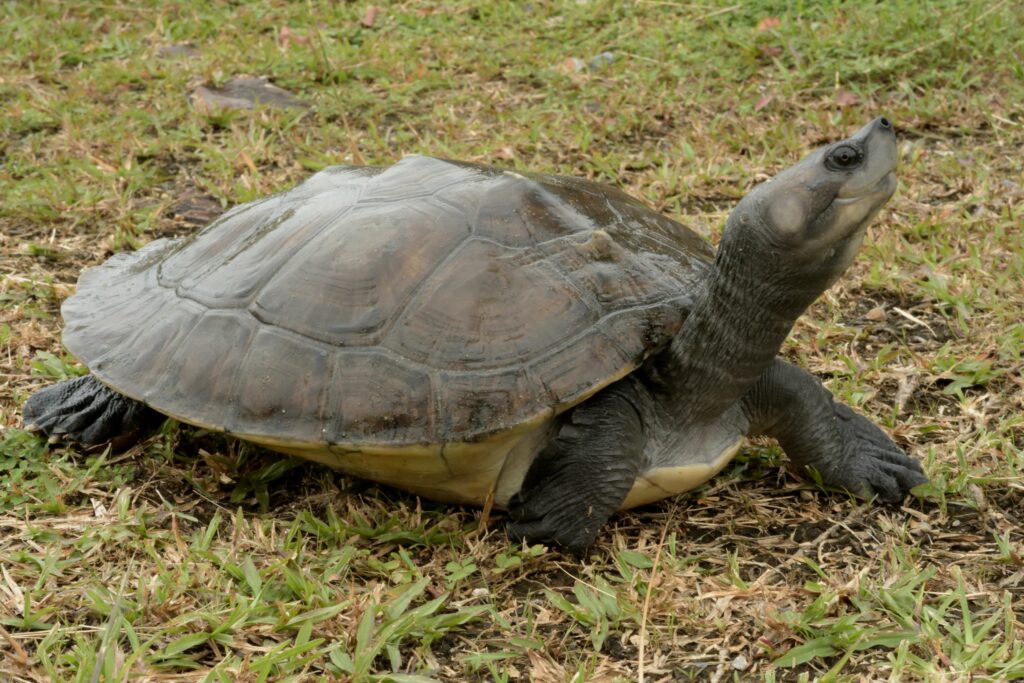
(Credit: Turtle Conservation Society)

(Credit: Palm Oil Detectives)
- Nesting season is between January – March (Terengganu) & November – January (Kedah & Perak)
- The river terrapins only lay 25 – 35 eggs yearly which is very low in productivity compared to sea turtles which lay around 100 eggs.
- They mature at 20 years old and can live up to around 80 years old.
- Their eggs and meat used to be a royal delicacy served to sultans back in the olden times but their eggs are now banned from eating.
- Since river terrapins are a ‘totally protected’ species, you can be fined and get in jail if you collect and sell them according to Wildlife Conservation Act 2010.
Duty to help
Dr Chen now runs the Turtle Conservation Centre which she co-founded with her former mentor, Dr Chan Eng Heng, who’s also a turtle conservationist. They both started the society in 2011, fueled by their passion and a sense of responsibility towards turtles.
READ MORE: Here’s Who You Have To Thank For Saving Malaysian Turtles
When asked about why she choose to focus on river terrapins, Dr Chen said that other turtles, such as sea turtles are very popular worldwide and found in various other countries. So there are already a lot of researchers, scientists and government agencies working together to save sea turtles. However, river terrapins are only found in 3 countries and they need a lot more support to be protected.
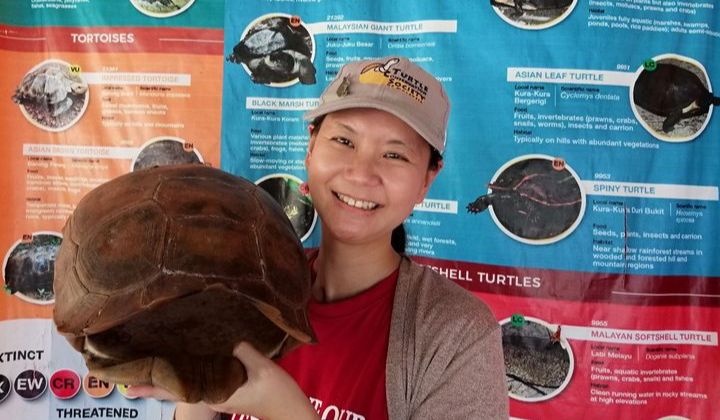
(Credit: Turtle Conservation Society)
Dr Chen further stated that she first learned about terrapins as a student in 2004. It was when she did her master’s study did she dig deeper into this species and felt a sense of obligation to protect it.
As Albert Einstein once said, if we have the privilege to know, then we have a duty to act.
Dr Chen Pelf Nyok, Co-Founder of Turtle Conservation Society & Turtle Conservationist
So I feel like it’s my privilege to know these terrapins and it’s my duty to get intimate with the challenges that they face.
I cannot sit around and wait for some better researcher or someone more passionate person to come and take action. So that’s why I got into terrapin research although it’s not something you hear people do frequently.
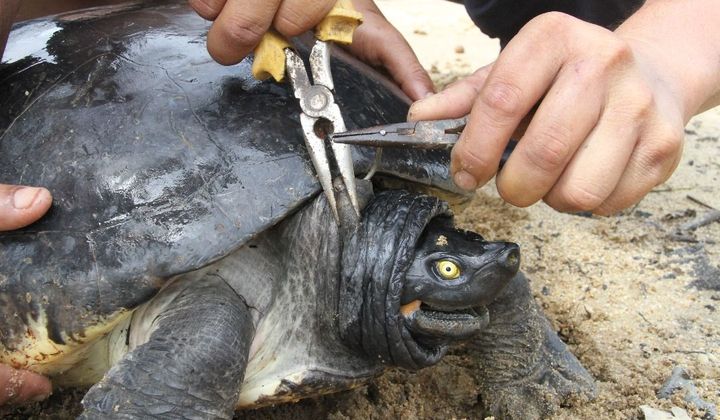
(Credit: Turtle Conservation Society)
When asked about her most memorable activity while being a turtle researcher, Dr Chen reminisced about her first time letting go of the terrapins in the river.
“The first time we released terrapins into the river, I had mixed emotions. We have been taking care of them for about a year and then we had to release them into the wild. We can just hope for the best that they will survive,” expressed her.
Each time I’m releasing a terrapin, it feels like I’m releasing a child.
Dr Chen Pelf Nyok, Co-Founder of Turtle Conservation Society & Turtle Conservationist
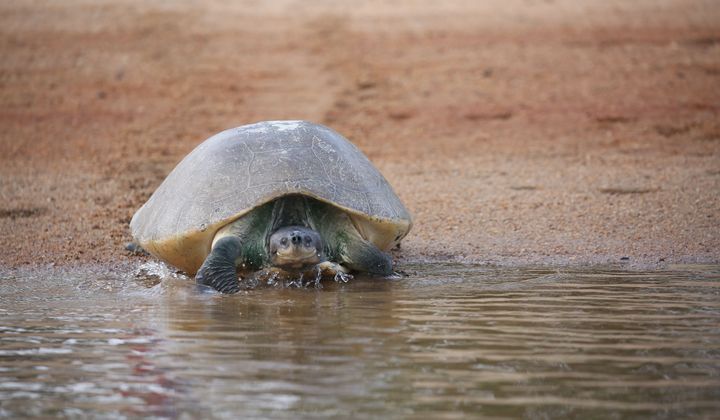
(Credit: Turtle Conservation Society)
To date, at TCS in Kemaman, they microchip about 300 adult terrapins and have released more than 4000 juveniles in the river. However, not all juveniles can make it to maturity once they enter the river. Nature is not all that forgiving.
Dr Chen also mentioned that recently, the terrapin population trend is very much decreasing, and at an alarming rate too. The success rate was only 35% in 2020 and it decreased to only 11% in 2021.
What can you do?
Generally, as they are in fact a non-government organization, they survive on grants given by the government and donations from generous individuals.
However, as a regular individual, Dr Chen said that you can actually help more than you think, just by using your passion and talent. Being aware of the endangered species goes a long way.
Learn and read more about our wildlife in Malaysia share this knowledge with your friends and families.
Dr Chen Pelf Nyok, Co-Founder of Turtle Conservation Society & Turtle Conservationist
And for those who are able to, please volunteer your time or your services to conservation organisations, depending on what you’re good at.
“For example, if you’re a photographer or videographer, volunteer and shoot some good pictures and videos of the wildlife or during the organisation’s conservation efforts for their portfolio. They also need some promotional videos of the wildlife to attract the public.
“If you’re a writer, get to know more about these organizations, what they do, what kind of wildlife they’re saving and what challenges they’re facing. You can put that in writing to educate people about these animals, at the same time.
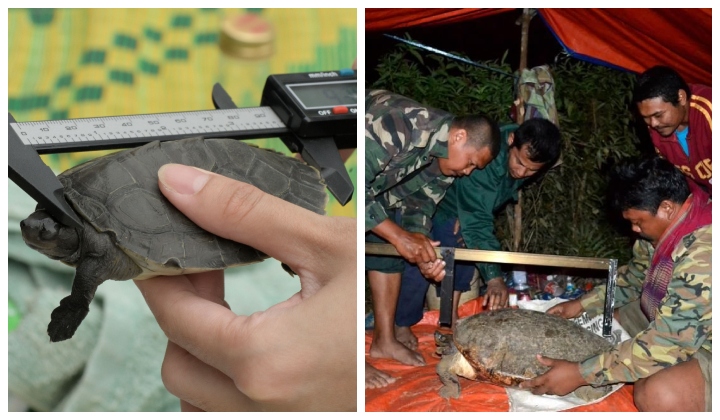
“If you’re a graphic designer, help design the posters, social media visuals or websites of these organisations. I tell you, most of us running these organizations do not have graphic designing skills. We’re mostly scientists who design very ugly-looking posters. It would mean a lot if you could spend your precious time with us and help.
“If you’re an accountant, you can help too. Many of us do not have an accounting background and yet, we are running an organization. We really need help. Bookkeeping, record keeping, financial management, we need people advising us on these things.”
Wanna see them?
If you wanna give the river terrapins a visit, you can head to the Turtle Conservation Society in Kemaman, Terengganu. You can make an appointment online through their website and they will take you to a 2-hour programme to see the terrapins when you arrive there.
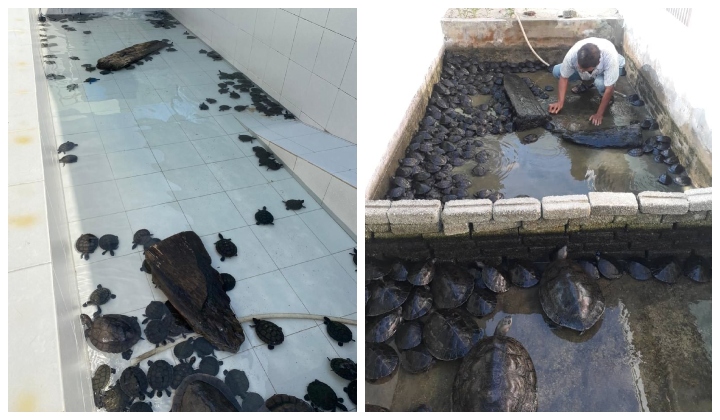
Additionally, every year in October, they will do a river terrapin day and release the juveniles back into the river. If that’s something that intrigues you, follow TCS’ social media to get more updates.
Other than TCS, you can also find river terrapins at government conservation centres under PERHILITAN such as these:
Pusat Konservasi Tuntung, Bukit Pinang (Perhilitan Kedah)
Pusat Konservasi Hidupan Liar Tuntung, Bota Kanan (Perhilitan Perak)
Pusat Konservasi Tuntung Sungai (PHKL) Bukit Paloh (Perhilitan Terengganu)
For more info, visit TCS’s Instagram, Facebook and Website.
READ MORE: The Firefly Whisperer Of Sungai Cherating, Pahang
READ MORE: Did You Know That The Oldest Civilization In Southeast Asia Is In Sungai Batu, Kedah?
READ MORE: Our Local Songbirds Are Being Trafficked Illegally, Says National Geographic Explorer
Share your thoughts with us via TRP’s Facebook, Twitter, and Instagram.




